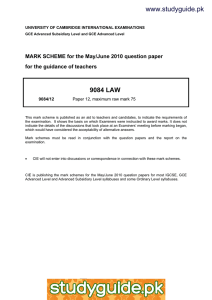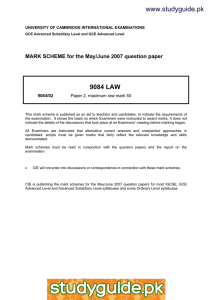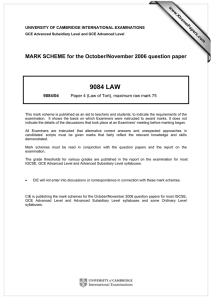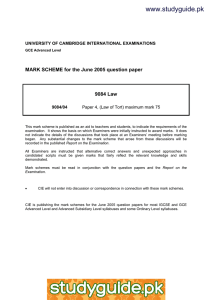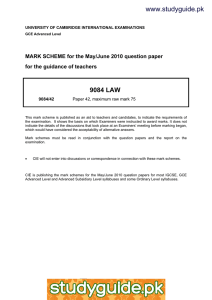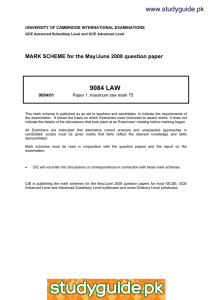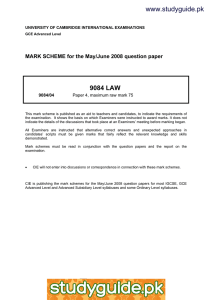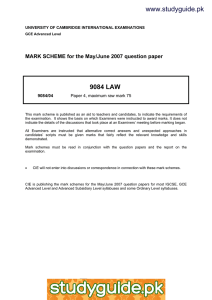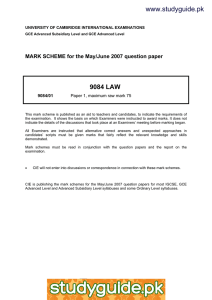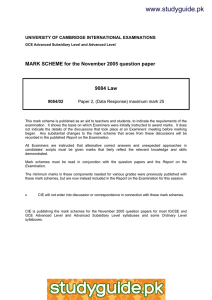www.studyguide.pk 9084 LAW
advertisement
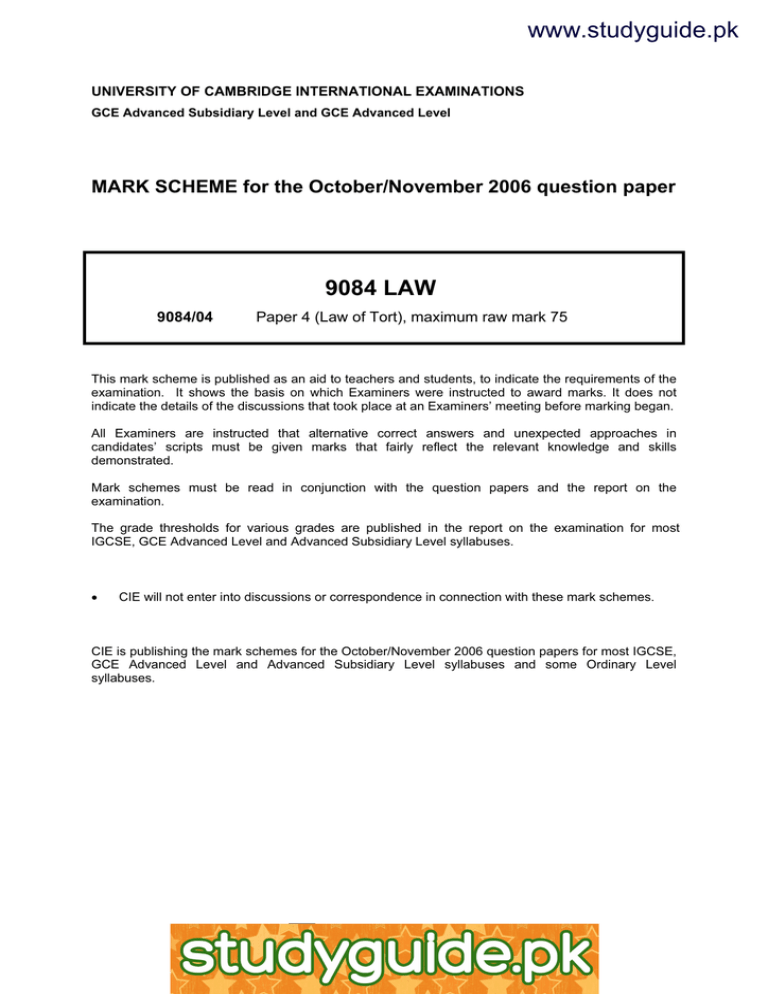
www.studyguide.pk UNIVERSITY OF CAMBRIDGE INTERNATIONAL EXAMINATIONS GCE Advanced Subsidiary Level and GCE Advanced Level MARK SCHEME for the October/November 2006 question paper 9084 LAW 9084/04 Paper 4 (Law of Tort), maximum raw mark 75 This mark scheme is published as an aid to teachers and students, to indicate the requirements of the examination. It shows the basis on which Examiners were instructed to award marks. It does not indicate the details of the discussions that took place at an Examiners’ meeting before marking began. All Examiners are instructed that alternative correct answers and unexpected approaches in candidates’ scripts must be given marks that fairly reflect the relevant knowledge and skills demonstrated. Mark schemes must be read in conjunction with the question papers and the report on the examination. The grade thresholds for various grades are published in the report on the examination for most IGCSE, GCE Advanced Level and Advanced Subsidiary Level syllabuses. • CIE will not enter into discussions or correspondence in connection with these mark schemes. CIE is publishing the mark schemes for the October/November 2006 question papers for most IGCSE, GCE Advanced Level and Advanced Subsidiary Level syllabuses and some Ordinary Level syllabuses. www.xtremepapers.net www.studyguide.pk Page 2 Mark Scheme GCE A/AS LEVEL - OCT/NOV 2006 Syllabus 9084 Paper 4 Assessment Objectives Candidates are expected to demonstrate: Knowledge and Understanding − recall, select, use and develop knowledge and understanding of legal principles and rules by means of example and citation Analysis, Evaluation and Application − analyse and evaluate legal materials, situations and issues and accurately apply appropriate principles and rules Communication and Presentation − use appropriate legal terminology to present logical and coherent argument and to communicate relevant material in a clear and concise manner. Specification Grid The relationship between the Assessment Objectives and this individual component is detailed below. The objectives are weighted to give an indication of their relative importance, rather than to provide a precise statement of the percentage mark allocation to particular assessment objectives. Assessment Objective Knowledge/ Understanding Analysis/Evaluation/ Application Communication/ Presentation Paper 1 Paper 2 Paper 3 Paper 4 Advanced Level 50 50 50 50 50 40 40 40 40 40 10 10 10 10 10 © UCLES 2006 www.xtremepapers.net www.studyguide.pk Page 3 Mark Scheme GCE A/AS LEVEL - OCT/NOV 2006 Syllabus 9084 Paper 4 Mark Bands The mark bands and descriptors applicable to all questions on the paper are as follows. Maximum mark allocations are indicated in the table at the foot of the page. Indicative content for each of the questions follows overleaf. Band 1: The answer contains no relevant material. Band 2: The candidate introduces fragments of information or unexplained examples from which no coherent explanation or analysis can emerge OR The candidate attempts to introduce an explanation and/or analysis but it is so fundamentally undermined by error and confusion that it remains substantially incoherent. Band 3: The candidate begins to indicate some capacity for explanation and analysis by introducing some of the issues, but explanations are limited and superficial OR The candidate adopts an approach in which there is concentration on explanation in terms of facts presented rather than through the development and explanation of legal principles and rules OR The candidate attempts to introduce material across the range of potential content, but it is weak or confused so that no real explanation or conclusion emerges. Band 4: Where there is more than one issue, the candidate demonstrates a clear understanding of one of the main issues of the question, giving explanations and using illustrations so that a full and detailed picture is presented of this issue OR The candidate presents a more limited explanation of all parts of the answer, but there is some lack of detail or superficiality in respect of either or both so that the answer is not fully rounded. Band 5: The candidate presents a detailed explanation and discussion of all areas of relevant law and, while there may be some minor inaccuracies and/or imbalance, a coherent explanation emerges. Maximum Mark Allocations: Question Band1 Band 2 Band 3 Band 4 Band 5 1 0 6 12 19 25 2 0 6 12 19 25 3 0 6 12 19 25 4 0 6 12 19 25 5 0 6 12 19 25 6 0 6 12 19 25 © UCLES 2006 www.xtremepapers.net www.studyguide.pk Page 4 Mark Scheme GCE A/AS LEVEL - OCT/NOV 2006 Syllabus 9084 Paper 4 Section A Question 1 ‘To enter another’s land without permission is never justifiable and is always actionable per se.’ Critically assess this statement. This question addresses the tort of trespass to land and some of its defences. Trespass to land should be defined: the unjustifiable direct interference with land which is in the immediate and exclusive possession of another. It should be explained that this tort is actionable per se, i.e. without proof of actual loss having been suffered. Candidates may then expand in outline and briefly explain the elements of possession of land and direct interference (e.g. entry, abuse of rights of entry, remaining on land, placing things on land). No more is expected. Does all non-permitted entry to another’s land amount to an actionable trespass? Candidates should consider the issue of accidental trespass. League against Cruel Sports v Scott and River Wear Commissioners v Adamson both suggest so, provided that negligence can be proved on part of trespasser. Recognized defences do exist and these should be investigated and reviewed by candidates: Licence – express or implied permission granted and terms not exceeded. Justification by law – for example the policeman’s right to enter and search premises (S17 PACE 1984) Necessity – restricted defence. Candidates might contrast approaches in Esso Petroleum Co v Southport Corporation, Rigby v Chief Constable of Northumberland and Monsanto plc v Tilly. Responses that attempt no critical assessment as required by the question will be limited to maximum marks within mark band 3. Question 2 ‘Traditionally, anyone who was partly responsible for the harm done to them could not recover in tort, but today, damages can be reduced taking account of fault on behalf of the claimant.’ Trace the statutory and case law developments that helped to bring about this change in approach to awards of damages in negligence cases and critically analyse the standard of care issues that may arise as a result. The focus of this question is the partial defence of contributory negligence. Up until 1945, any fault on the part of a complainant would have totally negated any claim made in negligence, however little the part that the complainant had actually played in the incident giving rise to the action. The Law Reform (Contributory Negligence) Act 1945 now provides that such claims need not fail; damages can simply be reduced in accordance with the complainant’s own degree of fault. Many of the cases on contributory negligence in negligence actions concern accidents (eg Baker v Willoughby, Brannon v Airtours plc), but candidates should be aware that it could equally-well apply to economic loss cases (eg Cavendish Funding Ltd v Henry Spencer & Sons Ltd), should a complainant have failed to take reasonable care of his own economic interests. Candidates should clarify that, if a claimant is not to be found contributorily negligent, he must have conducted himself appropriately, as judged against the same standard of care as expected of the defendant in the particular circumstances. It is an objective standard, with allowances made for children and disability if it would make it impossible for the standard to be reached. Issue re account taken of child’s age and development. Children develop at different rates and do get treated differently by the courts as a consequence – unsatisfactory state of affairs? Cases such as Yachuk v Oliver Blais Co Ltd and Evans v Souls Garage might be explored and contrasted. Issue re fault calculations. How can degree of fault be accurately and fairly assessed? For instance, in Baker v Willoughby, the complainant’s degree of fault was assessed differently at first instance and on appeal! Responses that attempt no critical analysis as required by the question will be limited to maximum marks within mark band 3. © UCLES 2006 www.xtremepapers.net www.studyguide.pk Page 5 Mark Scheme GCE A/AS LEVEL - OCT/NOV 2006 Syllabus 9084 Paper 4 Question 3 ‘An occupier of premises owes the same duty, the “common duty of care,” to all his visitors, except in so far as he is free to and does extend, restrict, modify or exclude his duty to any visitor or visitors by agreement or otherwise.’ (Section 2(1) Occupiers’ Liability Act 1957). Discuss the extent to which the occupier of premises can limit his liability. It is anticipated that candidates will open responses by explaining what is meant by a common duty of care. This is defined in S2(2) of the 1957 Act as ‘a duty to take such care as in all the circumstances of the case is reasonable to see that the visitor will be reasonably safe in using the premises for the purposes for which he is invited or permitted to be there.’ It may, thus, be sufficient for the occupier to ensure reasonable safety by displaying warning notices, provided that the wording and positioning of them ensure the reasonable safety of the visitor (S(4) ’57 Act); short, succinct examples should be provided by the candidate (eg Roles v Nathan). S2(3) still provides that there must be evidence of a voluntary acceptance of risks referred to in any warning notices. Likewise, S2(1) permits an occupier’s duty to be restricted, modified or excluded; this can include the use of notices. Candidates need to fully discuss and illustrate the possible application of the 1957 Act’s provisions. However, if entry to premises is permitted only by contract, or for business purposes, the right to do this is restricted by the provisions of UCTA 1977. S2(1), UCTA 1977, prevents occupiers from excluding liability for death or bodily injury caused by negligence (i.e. failing to meet the standard of the common duty of care). S2(2) UCTA permits occupiers acting in the course of a business or from premises used for business purposes, liability for a visitor’s property damage if reasonable in the circumstances. Candidates need to fully discuss and illustrate the possible application of the UCTA’s provisions. Responses that attempt no discussion as required by the question will be limited to maximum marks within mark band 3. © UCLES 2006 www.xtremepapers.net www.studyguide.pk Page 6 Mark Scheme GCE A/AS LEVEL - OCT/NOV 2006 Syllabus 9084 Paper 4 Section B Question 4 Assuming that Gungho Contracting Co. are found to be negligent, assess the extent to which Countrywide Bakeries Ltd might be compensated for the losses identified. This question asks candidates to assume proof of negligence, so no discussion of general principles of negligence is required and will receive no credit. The focus in this instance is clearly the compensation of the victim and requires discussion of the principles of remoteness of damage and of liability in negligence for pure economic losses. For any loss to be recoverable in an action in tort, that loss must not be so remote from its cause that it was not a reasonably foreseeable consequence of that cause (The Wagon Mound; Hughes v Lord Advocate). Candidates must make an assessment here. Were the three losses, in essence, reasonably foreseeable? Candidates might consider the courts approach in Page v Smith, Margereson v J W Roberts Ltd and Brown v Lewisham & North Southwark Health Authority in support of argument. More specifically, candidates might notice a remarkable similarity between the facts of the scenario and those in the decided case of Spartan Steel & Alloys Ltd v Martin. The issue of pure economic loss needs to be traced through case law development (eg Weller & Co, Spartan Steel, Junior Books). The law of tort distinguishes between losses suffered as a result of damage to person or property and those of a purely economic nature where no such damage has occurred. In the case of pure economic loss, the courts have been reluctant to allow claims. So what of this case? Loss (i) is a clear case of physical damage to property, so unless deemed too remote, is likely to be deemed recoverable. Loss (ii) would appear to be an economic loss arising from damage to property and, in that case, the claim, subject to remoteness, would also succeed. Loss (iii) looks like a pure economic loss and would probably not be compensated. Clear, concise conclusions should be drawn and advice given. Question 5 Discuss whether Graham can be held liable in negligence for the loss that Neil has sustained. This question focuses on liability for the results of negligent misstatements. Candidate will need to set the scenario in context by outlining the elements of negligence: duty of care, breach of duty and resultant loss. The principles on which such cases are decided were established in the case of Hedley Byrne v Heller & Partners and represented a significant departure from previous principles. In this case, the House of Lords said that in order to establish a duty of care, there must be a special relationship between the parties, a voluntary assumption of responsibility by the party giving advice and reliance by the other party on that advice or information and such reliance must be reasonable. Candidates need to examine whether there was a special relationship in this instance, as the outcome would seem to hinge very much on this. It was suggested by Lord Reid in Hedley Byrne v Heller & Partners that special relationships only cover situations where advice is given in a business context. The issue here, therefore would seem to be whether the statement made by Graham about Sparks & Mensa was made in a business or social context. The decision in Chaudry v Prabhakar ought to be considered in this context. If it is concluded that the circumstances imposed a duty of care on Graham, then candidates need to go on to consider the extent that reliance was placed on his statement and whether such reliance was reasonable. The decisions in Esso Petroleum Co Ltd v Manion and the Wills cases should probably be explored, applied and conclusions drawn. Clear, concise and compelling conclusions are expected. © UCLES 2006 www.xtremepapers.net www.studyguide.pk Page 7 Mark Scheme GCE A/AS LEVEL - OCT/NOV 2006 Syllabus 9084 Paper 4 Question 6 Garfield now wishes to seek redress for his injury and for his damaged property and he also wants to prevent cricket being played adjacent to his home. Advise Garfield whether he has grounds for any claim in tort and assess the likelihood of the success of these claims. Candidates will probably argue this case on the basis of negligence. However such an approach would seem destined to fail on the basis of no breach of duty. It would appear that, as in Boulton v Stone, given that a 3 metre fence had been erected that little more could have been done to prevent injury/loss. Responses based solely in negligence, will thus be restricted to marks within band 3 of the mark scheme. Garfield would be best advised to bring his case in private nuisance, on the basis that there is an indirect interference with the use and enjoyment of land in his possession. Candidates should consider the factors of locality (St Helens Smelting Co v Tipping), duration (Crown River Cruisers Ltd v Kimbolton Fireworks Ltd), and sensitivity of the complainant (Robinson v Kilvert) and draw conclusions. The possible defences of prescription (Sturgess v Bridgman) and social utility (Boulton v Stone) should also be explored here. If the nuisance is to be curtailed, the only remedy, which can be sought against the cricket club, is a prohibitory injunction. Candidates should explain the nature of the remedy and point out that it is an equitable one and therefore only awarded at a court’s discretion. Limitations on such awards must also be explored and conclusions drawn. Compensation for injury to his person cannot be sought in nuisance; claims are limited to those associated with loss of enjoyment of his land. Any action would need to be based in negligence. Candidates are expected to discuss the issues and draw clear, concise and compelling conclusions. © UCLES 2006 www.xtremepapers.net

